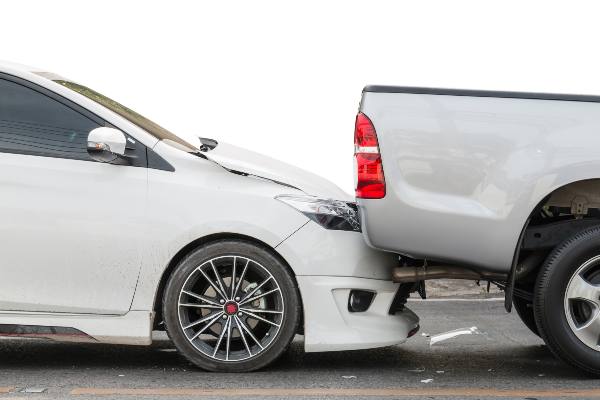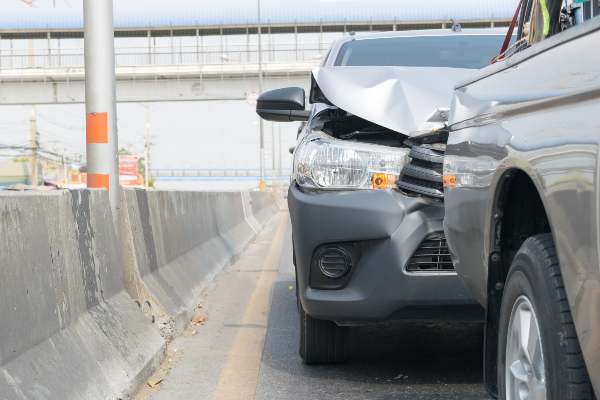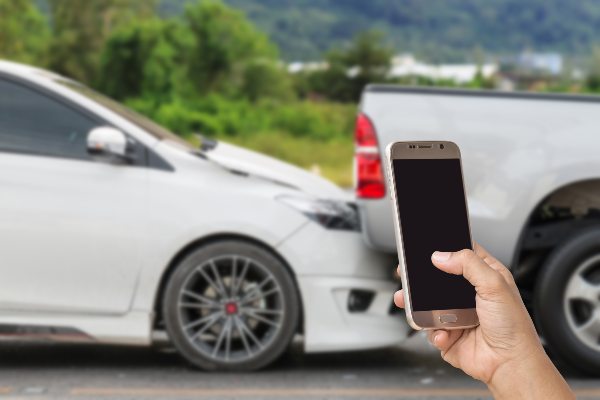
Menu

Menu
Most believe that rear-end crashes are not half as serious as most other accidents.
Partly true, but highly misleading.
While most rear-end cases are nothing but minor fender benders that most people don’t even feel worth pursuing, rear-ending can be pretty dangerous. It all depends on the speed and momentum of the vehicle that crashed into yours, and thus the extent of damages can vary.
If you’ve been in a serious rear-end crash, you should not hold back from demanding your legal right for financial compensation.
Let’s understand what rear-ending is, how it happens, and most importantly, whether you can sue the at-fault driver.

Rear-ending is exactly like it sounds, someone hits your car, bumper to bumper, but from the rear.
Usually, the person hitting the vehicle from the rear is considered the at-fault party.
For instance, if you were driving at an average speed and came to a halt when you saw the yellow light, and the driver behind you misjudged it, failing to stop in time, and this resulted in a collision, you won’t be blamed for it.
Even though you stopped when the signal was yellow (as a precaution), not red, it was still the other driver’s responsibility to drive safely and to maintain a distance from your vehicle. If they failed here, it’s their problem.
Of course, the driver in the rear is not always to blame.
For instance, if you were driving along a private lane and someone backed up their vehicle all of a sudden, bringing it in front of you, and you failed to stop in time (because you were taken by surprise), you can’t be blamed for the collision.
Although you did hit from the rear, it was not you but the other party that acted neglectfully.
Thus the exact scenario of rear-ending cases varies and so does the percentage of blame assigned to people involved.
But on the road, in most cases, the rear driver’s negligence is the cause of such crashes. Speeding, aggressive driving, impatience, and delayed reaction times (due to alcohol, drowsiness, drugs, etc.) are all to be blamed here.
Distracted driving is no less of a problem in this area, as most teenagers (and even some grown-ups) like to text and drive. If auto accident statistics tell us anything, it’s that texting and driving are not a good combination.
In most cases, the one who hit you from behind will be considered able for the damages. And based on the underlying cause, the damages may be very serious in some cases, thus ignoring things may not be an option as it is in a minor fender bender situation.
Just be sure to keep in mind how it all happened, at least the bits you can remember, because it will be helpful.
Before you go on and sue the other party for the damages you sustained, there are a couple of more urgent things you need to take care of. As with any other motor vehicle accident case, rear-end crashes (pressing that you've been involved in a severe accident, or at least moderately severe) must also be dealt with right from the moment they happen.
Here’s what you need to do:
This is the standard for all car accident cases, even in Texas; if there’s been a crash, the police must know about it. Of course, you can ignore the whole thing if it was a minor fender bender (it's never a good idea to ignore personal injury claims), but let’s presume that the crash was pretty bad.
The first thing you have to do is to call 911 and ask for the police, and if you’re hurt pretty bad (or someone else is), ask for medical assistance as well.
When the reporting officers arrive, narrate the whole event as articulately as you can while being completely truthful about everything. If you can’t remember some details, tell them that you’ll update the police about those parts later on.
Once the officers are done inspecting the whole scene and have compiled their police report, ask for a copy because you’ll need one.
If for some reason, the police can’t show up at the scene, you’ll have to go to the nearest police station and report the event yourself.
You’ll also have to have a chat with the other driver, that is unless they’ve run away (hit and run) or are inebriated, in which case is it best to keep a safe distance. But otherwise, you should talk, don’t be grim or aggressive, just ask for their personal information.
This information covers the name, ID, driver’s license, license plate number (photograph it), contact information, insurance provider, and so on.
With this information, you will be able to pursue the case further. If they ask for the same information, you should give it to them, honestly. They’ll most likely share the whole event with their insurance provider and thus you’ll be contacted soon after the accident.
At this stage, you should not discuss the blame, even if it is pretty obvious.

You also need to know how bad the damage was.
The full extent may not be apparent immediately but the bits you can see, be sure to note down. Don’t give any statement about the extent of your economic and non-economic losses until you’ve had your case reviewed by an accident attorney.
Why?
If you inadvertently downplay your damages, you won’t be able to demand as much in compensation and thus end up with a nominal sum. When the insurance adjuster calls, be sure not to give a definite statement, just acknowledge that the accident did happen and the basic stuff, but leave the rest for later.
Your lawyer will present a much fairer picture in this regard by summing all the short-term and long-term economic and non-economic damages that you had to face, such as:
And so on…
Once you’ve got a car accident lawyer on board, which you should do without delay, you can get a fair estimate of your losses (and thus a fair recovery), but be sure to assess the damages at the scene too.
All of the aforementioned will amount to nothing unless you can prove it.
Firsthand evidence is the strongest of the kind, so be sure to whip out your camera phone and start photographing the whole scene. Your photos and videos should clearly show the damage your vehicle sustained and your injuries if they are apparent.
Be sure to get the whole accident scene in your frame to show how the accident was not your fault (by showing that you were hit from the rear).
If you see any bystanders, approach them and ask for their contact information, very politely, because these people may become witnesses for your case.
And yes, you should not delay calling a car accident lawyer, in fact, do so as soon as possible, even if only for consultation.
They will be immensely helpful for forwarding your accident claim to the insurance company and demanding a fair settlement as per the auto insurance policy (i.e. within the injury liability insurance coverage and as per company rules and regulations).
Some cases, such as rideshare accidents, can be difficult to navigate on your own. If you were injured as a passenger in an Uber accident, contact a Houston Uber accident law firm to review your case. An experienced attorney will be able to negotiate with the insurance company on your behalf.
Now comes the real question: can you sue the negligent driver?
And the answer is a definite yes, given that they are at fault, or at least primarily at fault. Since Texas is an at-fault state, if you go through the aforementioned steps and have enough evidence to suggest that the negligent party is liable for your damages then you have every right to sue them.
This, of course, is not necessary.
Your car accident lawyer will try to win you a settlement from the insurance company as per the insurance policy limits, but if their best offer is inadequate, you can take things to the court for a bigger settlement.
Who knows your negligence claim may win you some punitive damages, i.e. let's say if the crash scene was rather disturbing, or if the rear-ending involved a company vehicle (employer negligence), or if the offender had a record of violating traffic laws.
Even if you share a minor degree of fault (called comparative fault), but by no more than 50%, you can still sue the other party under the comparative negligence law, albeit for a smaller sum.
However, in the case of an uninsured driver, you will have to fall back to your own insurance policies (personal injury protection) and may even need additional insurance support from your health insurance for your insurance claim, i.e. property damage coverage and other reimbursements.
You may be holding back from getting a car accident lawyer because you feel that you won’t be able to pay the legal fees.

Well, if that is the case then no worries, because the personal injury attorneys at Calhoun Meredith handle personal injury cases on a contingency fee basis. This means that you can rest assured about the financial part and instead spend the time resting and feeling better (if you’re hurt).
And as mentioned earlier, even if you do share a percentage of fault, but less than 50% (highly unlikely for a rear-end car accident), you can still sue.
Call us today, and leave all of your worries behind!